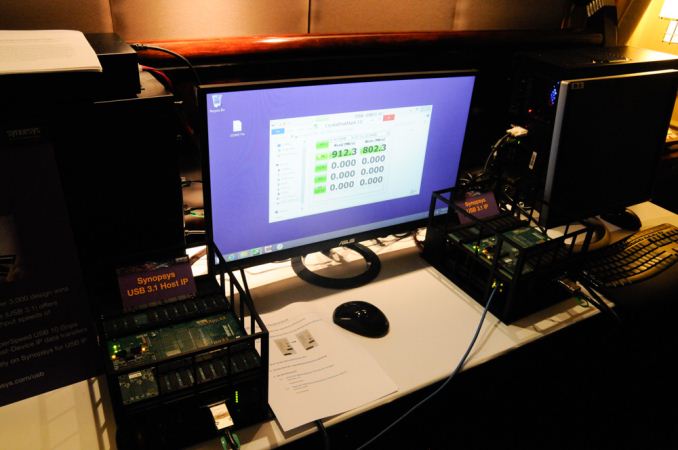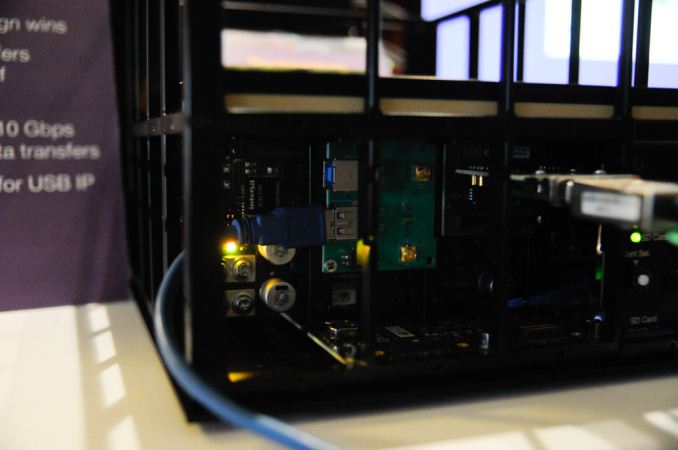USB-IF Updates Us on Type C Connector, Demonstrates USB SuperSpeed 3.1 Transfers
by Brian Klug on January 7, 2014 2:36 PM EST- Posted in
- Trade Shows
- CES
- USB-IF
- CES 2014
- USB 3.1

December of last year, the USB-IF announced that the definition of a new type of compact connector, dubbed type C, was underway. After pushback from the USB 3.0 micro-B connector, which added a lobe for the USB 3.0 data lines in addition to the signaling and port for USB 2.0 micro-B, many saw the definition of a type C connector as a way to learn from previous lessons and design a connector for better, sleeker industrial designs and with a new emphasis on mobile devices like tablets and smartphones.
The type C connector is still in development, and there aren't any current renderings or drawings, but what has been laid out are the design goals for the new connector design. The connector will be reversible, and able to negotiation which end is host or client (direction-agnostic) with type c connectorization at both ends, although cables will still come in type-A to type-C combinations for use with power adapters and current generation hosts. In addition it will be around the same size as the current USB 2.0 Micro-B connector and catered toward enabling the kinds of thin and sleek industrial designs smartphone, tablet, and even notebook OEMs desire. Type C will work with USB 3.1 and the power delivery specification, in addition to including some extra pins for growth and building out the standard in the future, the goal is to make this the connector for the next 10 years. In addition, the standard will define an intermediary adapter for going from current 2.0 or 3.0 micro-B connectors to the new type C connector. I'm told to expect the Type C connector to have drawings and be better understood probably before the next IDF.
In addition USB-IF showed two demos of USB 3.1, the new standard which enables up to 10 Gbps transfer speeds by doubling the clock rate and also moving to a more efficient 128b/132b coding scheme with just 3 percent overhead, compared to the 20% overhead in 10b/8b from USB 3.0. Both demos were implemented on FPGAs, and showed transfer rates right around 1 GB/s (8 Gbps), the second using Synopsis' FPGA implementation over current generation USB 3.0 cables.
















31 Comments
View All Comments
SlyNine - Tuesday, January 7, 2014 - link
By carelessly forcing connectors in to each other :PAlexvrb - Wednesday, January 8, 2014 - link
You just defined what happens when you have kids attempting to plug in their devices. No thanks! The more bulletproof the better.flatrock - Tuesday, January 7, 2014 - link
Not enough space on a thin device for anything but a flat connector. Round is also only simple if you can have concentric contacts like a headphone jack. Otherwise orienting a circular connector is far worse than a flat one. A reversible flat connector does seem best.robl - Tuesday, January 7, 2014 - link
I recently had to upgrade my nexus7 tablet, as the 2012 version uses the tiny usb port to charge, and it's fragile. Our kids kept tripping over it. Something bent inside and charging became very difficult. So ... I hope the new connector port builds some reliability into it to take abuse and keep working.SunLord - Tuesday, January 7, 2014 - link
Why were you charging where someone could trip over it?sweenish - Wednesday, January 8, 2014 - link
Not just trip, but constantly trip.name99 - Wednesday, January 8, 2014 - link
Well of course there IS a solution to this --- make the thing magnetic like Apple did...I'm not sure why Lighting is not magnetic like MagSafe. I keep hoping it's because Apple didn't have time to iron the bugs out, and it's coming; but maybe it's basic physics --- maybe there simply isn't enough space to stick a magnet large enough to do the job in a phone, and prevent it from interfering with the speaker?
nemesis4670 - Friday, February 28, 2014 - link
Nonsense...the reason is because Apple is cheap and desperately clings onto insane profit margins. The Sony Xperia Z1 smartphone has a magnetic charger port just like MagSafe. They even sell a cool magnetic charger dock so you just plop the phone in and it charges. But also a magnetic charging cable with USB on the other end. It's on the side of the device. But it also includes a MicroUSB slot for data transfer.CharonPDX - Tuesday, January 7, 2014 - link
Obligatory xkcd reference:http://xkcd.com/927
chekk - Tuesday, January 7, 2014 - link
So the sequential speeds are fine, but hopefully speeds for smaller files is improved. Overall, eSATA still beats USB3 by a huge margin when transferring pictures, etc.